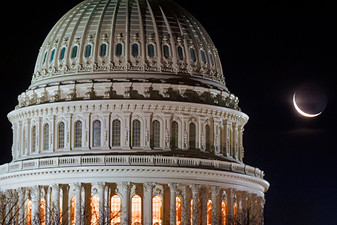|
By Cecile Entleitner, Associate, Blakey & Agnew
Halloween season has descended upon Washington D.C., though the frights may take a different form on Capitol Hill than elsewhere. For months, Congress has been haunted by four major legislative items on their to-do list: annual appropriations for federal agencies; the bipartisan infrastructure package containing a full five-year surface transportation reauthorization and additional funding; the broader "human infrastructure" reconciliation package; and addressing the debt ceiling. As lawmakers grapple with ghosts of looming deadlines, short-term extensions, and heated negotiations, things may get spooky if Congress does not act soon.
On September 30, President Biden signed into law a continuing resolution, a stopgap measure providing funding for federal agencies – thereby narrowly preventing a government shutdown on October 1, which is the start of the government's new fiscal year. The legislation extends funding at fiscal year 2021 levels until December 3, 2021, allowing Congress additional time to advance a full-year appropriations package or subsequent continuing resolution before they "turn into a pumpkin" and face another potential government shutdown. While a previous iteration of the bill, which was passed by the House of Representatives, included a provision to suspend the debt ceiling until 2022, this section was removed from the final version due to opposition from Senate Republicans.
However, lawmakers faced another important funding deadline on September 30 this year: the expiration of Highway Trust Fund (HTF) spending authority. Although Congress successfully circumvented a complete government shutdown, HTF authorizations briefly lapsed for the first time since 2010. While the House intended to hold its final vote on the Senate-passed bipartisan Infrastructure Investment and Jobs Act (IIJA) during the week of September 27, the vote was ultimately postponed. House leadership is seeking to advance the bill through a two-track approach, linking its final passage to the forthcoming broader reconciliation package. Since the reconciliation bill – which will incorporate many Democratic social and climate policy priorities – was held up amid ongoing negotiations, leadership recognized there was insufficient support for the IIJA within the party and delayed the vote.
As a result, the U.S. Department of Transportation temporarily furloughed nearly 3,700 employees and ceased all federal-aid highway programs. Fortunately, the lapse did not last long. In the
|

following days, the Surface Transportation Extension Act was passed by Congress and signed into law on October 2, allowing USDOT to fully resume operations. This extension will expire on October 31, by which time Congress must pass a long-term reauthorization bill, such as the IIJA, or an additional stopgap measure.
Congressional Democrats and the White House are still negotiating the scope, size, and details of the Build Back Better reconciliation bill, seeking to obtain support from both moderate and progressive caucus Members. Unified support will be instrumental as the legislation will require affirmative votes from all 50 Senate Democrats and nearly all House Democrats to ensure passage. While initial proposals featured a $3.5 trillion overall price tag for the package, the final amount will likely be closer to $2 trillion to secure votes from the moderate wing of the party. Due to the intricate political considerations, complexity of policy issues, and overall size of the bill, progress has been slow and negotiations are expected to continue into November and potentially December. If this holds true, and the IIJA remains linked to the Build Back Better package, Congress will likely opt to pass another short-term HTF extension toward the end of October until both the IIJA and reconciliation bill can advance concurrently.
Rather than completely suspending the federal debt ceiling as the House originally proposed, Congress is currently finalizing legislation to increase the debt limit by $480 billion. The Treasury Department estimates this amount will be sufficient to sustain debt payments until December 3 – the same date the short-term appropriations expire and the potential timeframe for both the IIJA and reconciliation votes. The coming months will ultimately show whether Congress will deliver tricks or treats on these four urgent funding measures or if ghosts of deadlines past resurface during the holiday season in December.
Blakey & Agnew, LLC is a public affairs and
communications consulting firm based in
Washington, DC.
|


